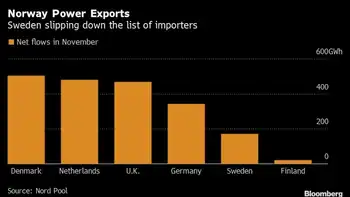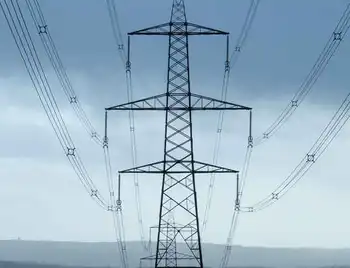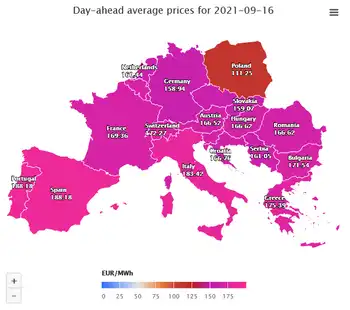Alcoa bid for power called boggling
By Knight Ridder Tribune
NFPA 70e Training - Arc Flash
Our customized live online or in‑person group training can be delivered to your staff at your location.

- Live Online
- 6 hours Instructor-led
- Group Training Available
Do the same companies now receiving power get to keep it largely because possession is nine-tenths of the law? Or should the power be put to its best potential use, political ramifications be damned? Western New York might not have to wait long to read the handwriting on the wall - in this case, on that of the State Capitol. Alcoa Aluminum, the state's largest purchaser of cut-rate hydropower, is pressing to extend the status quo with a new deal for its two plants in northern New York. That means:
- Electricity at about a quarter of the market rate, at an annual savings of $185 million.
- Enough juice to power the plants completely, five times the allocation of any manufacturer in Western New York.
- A longtime deal of 30 years, as opposed to the five-year contracts most discounted power customers here receive from the State Power Authority.
The prospective cost is staggering - $5.6 billion over 30 years, according to a calculation by The Buffalo News - making it almost certainly the most costly economic-development subsidy in state history. That works out to about $148,000 per year, or $4.4 million over 30 years, for each job. By contrast, the federal government caps the subsidy for several major economic-development programs at $35,000 per job for the life of the subsidy.
Alcoa would gobble that up in the first three months of the proposed 30 years.
Alcoa, which has downsized in recent years, now employs about 1,250 at its two plants in Massena. Company officials have said they don't expect to trim more jobs in the foreseeable future, but they also don't want to guarantee more than 900 positions - three-quarters of the present work force. Greg LeRoy, a national expert on economic development subsidies, describes the agreement Alcoa seeks as the richest he ever has seen. "It's an exceptionally lavish deal," said LeRoy, executive director of Good Jobs First, a Washington, D.C., research and advocacy organization that monitors government economic development subsidies.
Negotiations between Alcoa and the State Power Authority started about a year ago, even though the contract doesn't expire until 2013. Alcoa apparently wants a long-term commitment before deciding whether to spend as much as $600 million to upgrade its Massena plants. No substantive discussions have been held in about six months. While Power Authority officials declined to comment, the stalled negotiations indicate they want to drive a harder bargain. Alcoa turned to Gov. Eliot L. Spitzer, who in turn got Dan Gundersen, his top economic development official for upstate, involved.
As a result, negotiations resume July 9. "The governor would like to be assured that Alcoa will continue to be a presence in the North Country," said Gundersen, upstate director of the Empire State Development Corp., the state's economic development arm. Alcoa presents a complicated issue for state officials. The company is the largest employer in the state north of Syracuse. Its importance to the regional economy will grow next year, when General Motors closes a plant in that area. "It is the lifeblood of the entire North Country north of Watertown," said Thomas Snyder, an attorney from Massena and author of "Power Dam Politics," a book that took a critical view of the Power Authority.
Alcoa is not only a cornerstone of the North Country economy, but has been an important business partner with the authority for a half-century. Alcoa's facility in Massena is the oldest continuously operating aluminum plant in the world, dating to 1903. The company owned a portion of the water rights to the St. Lawrence that the authority wanted to operate a hydropower plant. Surprising numbers The authority needed a large power customer to back the bonds sold to build the St. Lawrence-Franklin D. Roosevelt Power Project in Massena in the 1950s, and Alcoa provided it the necessary business and water rights.
Alcoa paid a premium for power in the early days, but has since saved hundreds of millions of dollars, if not more, on its power bills. At present, Alcoa receives an annual discount of about double its payroll. That is, for every one dollar Alcoa pays its workers, the state gives it $2 in discounts. If Alcoa maintains employment at its current level, invests $600 million in the plant and as proposed, contributes $10 million to a regional economic development fund, its outlay would come to $3.4 billion over 30 years - far short of the $5.6 billion in discounts it would receive.
"The numbers surprise me and would surprise a lot of other people," said Frank Mauro, director of the Fiscal Policy Institute, an Albany watchdog organization focused on tax and fiscal issues.
"If the numbers are correct, the state certainly should be doing some sort of cost-benefit analysis before making its decision," he said. LeRoy, of Good Jobs First, said the proposed deal is way out of line with even the most generous subsidy deals he has studied over the years. " One-hundred-forty-eight-thousand dollars per job would be a big subsidy over the life of a 20-year deal, much less annually," LeRoy said. How do Alcoa officials justify their proposal? "We provide between 1,200 and 1,300 highly paid positions in an economically depressed area," said Susan Flynn, Alcoa spokeswoman.
Compared with Alcoa's allocation of 478 megawatts, industries here collectively have access to up to 695 megawatts.
Few, if any of the contracts extend beyond 2013. What the governor and authority do in Massena has implications for what happens in Western New York. Occidental Chemical Corp. in Niagara Falls, for example, is the largest local recipient of discounted hydropower generated at the Niagara Power Project. Last year, its discount was worth $28.7 million, even though it employs only 258 employees. That works out to about $111,000 per job.
The $24.1 million discount for Olin Corp., the second-largest recipient, is even costlier - $150,000 per job annually. An investigation published two months ago by The News found that much of the discounted hydropower sold to industries here is squandered.
Five companies that receive half the power employ just 7 percent of the work force. The News also found that companies that fail to meet their job obligations usually are not punished and that the criteria used to allocate the power is outdated, favoring declining industries at the expense of new economy enterprises.
A 2001 study commissioned by the Power Authority came to the same conclusion, saying that 85 percent of the power could be put to better use. LeRoy characterized the subsidies to recipients here as "a sweet deal that's unfair to everyone else" and said those now sought by Alcoa are akin to "an entitlement that's an enormous gift from the taxpayers."











